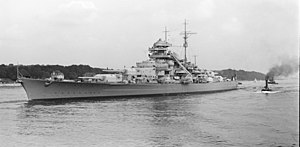
Back بارجة من فئة بسمارك Arabic Лінейныя караблі тыпу «Бісмарк» Byelorussian Линейни кораби тип „Бисмарк“ Bulgarian Třída Bismarck Czech Bismarck-Klasse (1939) German Clase Bismarck Spanish نبردناو کلاس بیسمارک Persian Bismarck-luokka Finnish Classe Bismarck (1939) French אוניות המערכה מסדרת ביסמרק HE
 Bismarck underway near Blankenese in 1940
| |
| Class overview | |
|---|---|
| Name | Bismarck-class battleship |
| Operators | |
| Preceded by | Scharnhorst class |
| Succeeded by | H class (planned) |
| Built | 1936–1941 |
| In commission | 1940–1944 |
| Completed | 2 |
| Lost | 2 |
| General characteristics | |
| Type | Fast battleship |
| Displacement | |
| Length | |
| Beam | 36 m (118 ft 1 in) |
| Draft | 9.30 m (30 ft 6 in) standard[b] |
| Installed power | |
| Propulsion |
|
| Speed | 30 knots (56 km/h; 35 mph) |
| Range |
|
| Complement |
|
| Armament |
|
| Armor | |
| Aircraft carried | 4 × Arado Ar 196 |
| Aviation facilities | 1 double-ended catapult |
The Bismarck-class was a pair of fast battleships built for Nazi Germany's Kriegsmarine shortly before the outbreak of World War II. The ships were the largest and most powerful warships built for the Kriegsmarine; displacing more than 41,000 metric tons (40,000 long tons) normally, they were armed with a battery of eight 38 cm (15 in) guns and were capable of a top speed of 30 knots (56 km/h; 35 mph). Bismarck was laid-down in July 1936 and completed in September 1940, while the keel of her sister ship, Tirpitz, was laid in October 1936 and work finished in February 1941. The ships were ordered in-response to the French Richelieu-class battleships, themselves laid-down in-response to the Italian Littorio-class battleships. The Bismarck-class was designed with the traditional role of engaging enemy battleships in home waters in mind, though the Oberkommando der Marine (High Command of the Navy) envisioned employing the ships as long-range commerce raiders against British shipping in the Atlantic Ocean. As such, their design represented the strategic confusion that dominated German naval construction in the 1930s.
Both ships had short service careers. Bismarck conducted only one operation, Operation Rheinübung, a sortie into the North Atlantic to raid supply convoys sent from North America to Great Britain. During the operation, she destroyed the British battlecruiser HMS Hood and damaged the new battleship Prince of Wales in the Battle of the Denmark Strait. Bismarck was defeated and sunk in a final engagement after a three-day chase by the Royal Navy. Although some disagreement over the cause of the sinking persists, evidence reviewed by Robert Ballard and James Cameron indicates that her loss was due to a combination of battle damage and scuttling, with the Royal Navy battleships Rodney and King George V inflicting fatal damage before Bismarck's crew scuttled the foundering ship.
Tirpitz's career was less dramatic; she operated in the Baltic Sea briefly in 1941 before being sent to Norwegian waters in 1942, where she acted as a fleet in being, threatening the convoys from Britain to the Soviet Union. She was repeatedly attacked by the Royal Navy and Royal Air Force between 1942 and 1944, but she was not seriously damaged in these attacks. In 1944, Lancaster bombers hit the ship with two Tallboy bombs, which caused extensive internal damage and capsized the battleship. Tirpitz was broken up for scrap between 1948 and 1957.
Cite error: There are <ref group=lower-alpha> tags or {{efn}} templates on this page, but the references will not show without a {{reflist|group=lower-alpha}} template or {{notelist}} template (see the help page).
© MMXXIII Rich X Search. We shall prevail. All rights reserved. Rich X Search